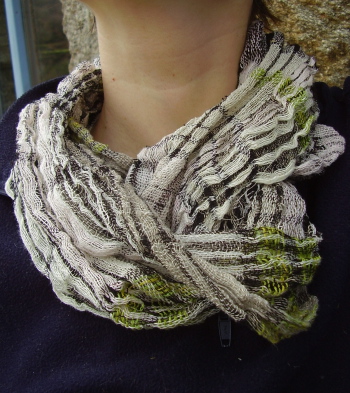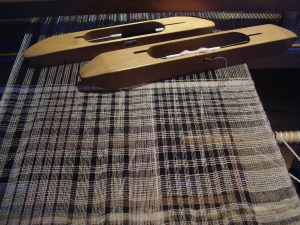¿Te interesa realizar un curso online de tècnicas del tejido en telar con Anna Champeney?Si te interesa aprender técnicas de diseño y tejido en telar de bajo lizo online, escríbanos y suscribir a nuestro boletín.
 Contacta con nosotros | You may have heard about the red alert storm warnings in north Spain yesterday, 27 February 2010. Well, Xynthia, as the storm was called in Galicia, raged all around us yesterday afternoon and evening. We battened down the hatches – well, closed the shutters on our stone workshops – and weathered the storm. here in north Spain we have escaped much of the snow affecting more northerly European countries but we have had torential rains which have led to severe flooding in some areas. Here in the Ribeira Sacra, at 600m up, it is the wind which affects us most, and not least during Xynthia, where winds of up to 200 km/h were recorded. In fact, I was so carried away with my weaving during hurricane Xynthia that the constant roar of the wind and the flickering on-and-off of the electric lighting and the radio didn´t really affect me, except when the light began to fade and I had to go and get a candle. Such is the excitement of weaving fine singles silk, linen and 52/2 overspun wool into a gorgeously-textured scarf. 
I´m going to take it with me when I demonstrate next week at Xantar (= “Lunch”) the 5 day food festival in Ourense, the city 40 minutes away from Anna Champeney Textile Studio.
Bye for now!
An intensive 3-week weave course or Textile Assistantship at Anna Champeney Textile Studio in Galicia, north Spain enabled Kathleen McCormick to turn weaving into a part-time career in Ireland. Here she tells us about the experience .

What made you choose to do the 3-week Textile Assistantship in Anna Champeney Estudio Textil in Spain, as opposed to a conventional beginners´ weave course? I wanted to become immersed in the whole process and world of hand-weaving. Another factor which influenced me was knowing – from a previous visit – that the studio was in an attractive setting in Spain. I had got to know Anna through a previous visit and I fell in love with Galician Felpa (loop-pile) weaving. Also, I had met Anna´s partner, basketmaker Lluis Grau, and so I was able to combine weaving tuition with basketry. You have been a professional basketmaker in Ireland for many years. What attracted you to weaving on a loom? I used to spin my home-grown fleece from my own sheep. I hand-dyed it but could only use it by knitting it. When I discovered that I could learn to weave this opened up a whole new world to me. Now I could do something with the homespun fleece and dye wool to my requirements. On the course we did some natural dyeing – which I already knew about, albeit in a somewhat haphazard way. Anna taught us to chronicle what we did and how we came to get the resultant colour. Anna also taught us to use other dyes. I now dye Irish fleece in white, mid-grey and dark Jacob´s fleece. What did you learn during the three-week assistantship course? What didn´t I learn is the question on the three weeks of the assistantship??? One of the really important things I learned, which is very personal, is that “no-one could take this from me” – meaning that I was actually there, I was actually doing this course and the value of it would always be with me, whatever life threw at me. I learned discipline in work methods – Keeping time is essential (being up early and at the textile workshop is a very important thing), but then Tracey, my co-assistant, and I both had a good work ethos. I learned about the history of Spanish felpa weaving and some of the social structure of the women who not only wove the felpa bedcovers but also grew the flax for the linen yarn. I learned about the structure of weaving. Making a warp on the warping mill and the method of warping a loom (one of several methods), weaving various patterns which I found very difficult due to age and lack of ability to retain patterns in my memory beyond two minutes, and several different fabric finishing techniques. Anna gave us tasks she would have done herself thus giving us a good view of the life of a professional weaver. Tracey and I brought humour into the workshop, seriousness in our intention to learn. We spent the mornings doing jobs for Anna as weaving assistants and the afternoon was spent doing and learning weaving. Tell us about the most challenging part of learning to weave and use natural dyes. The biggest challenge for me in learning to weave was that I suffer from dyslexia for numbers and patterns – I do not know when my children were born nor in what year I got married or what year anything happened. If I try to remember how to read a pattern I panic, really, but give me a job of weaving and I can do it, can read th at pattern, and work out what needs to be done to create one particular job. I am actually quite a good weaver of rugs.
The asssistantship was fairly intense, but did you have the chance to explore the local area during the 3 weeks? If so, what were your impressions of the Ribeira Sacra in Galicia, north Spain, where Anna Champeney Textile Studio is located? I did have some time to myself for walking. The Ribeira Sacra is unbelievably beautiful, especially where Anna and Lluis live. the birdlife was second-to-none and I was there in the area twice, so I heard the cuckoo and the hoopoe and several other birds whilst out walking in the vineyards.
You now make and sell your own work from your craft studio in Ireland. How did you make the leap from being a beginner to actually starting to sell your work? Well, I have always made and sold whatever I have made. I think it´s just part of my character. Perhaps I am a “Chancer” too! Really, my friend Maire ni-Neachtain was a great help and encouraged me to sell and exhibit. I have been part of two Crafts Council of Ireland exhibitions and hope to sell rugs to the public through going to a national sale in May. Also, I sell my wares everywhere by talking about them to interested people, as well as getting the odd private commission.
You used a Louet table loom during the textile assistantship in Spain. What is your opinion of these looms and what looms do you now use? I think the Louet table looms that Anna has in her studio for courses are excellent to learn on or to use if you have limited space. I prefer a floor loom – especially for my rug weaving. I am using an old Glimakra floor loom but in the next few days I am to get a second loom which is Finnish.
What weave projects do you have planned for the future? I have in mind more rugs and I have the wool for them already. I did a five-day course with Jason Collingwod, who is the son of famous weaver, Peter Collingwood. Jason is an accomplished rug weaver, having learned fro mhis father, and he taught the technique of “Shaft Shifting”. I would love to set up one of the looms I have as an experiment in “shaft shifting”. It makes for a wonderful rug. I would also like to explore the world of tapestry weaving but have ideas to try which require time and time-out.
Can you offer any advice to those thinking of learning to weave themselves? Go to Anna and learn the basics of weaving and enjoy every minute of the experience!
And for more information on your work? I have two websites – one for weaving and one for baskets www.basketbarn.ie. Although the two crafts have things in common they are as different as glass blwoing and wood carving!!
Further Information about the Textile Assistantship – Click here
 kathleen weaving
 Sample weaving
 Ribeira sacra in north Spain
 galeguiño en felpa gallega, tejido por Anna Champeney Estudio Textil Now and again, in my Spanish (Galicia) folk textile research, I come across hand-woven bed-covers decorated with human figures or animals like the figure shown in this sample which I wove a few days ago. These coverlets use the technique of Galician Felpa (or gorullo), ancient loop-pile weaving technique which is over 1400 years old. It was one of the most common weaving techniques in this northern region of Spain. In 2009 I had the opportunity to examine Galician textiles in the museum stores of the Museo del Traje in Madrid (The Costume Museum). There I found one such coverlet, with not just one or two figures, but a whole collection of dancers and craftsmen, all picked out with Galician felpa, with hundreds of thousands of individual loops. The simple, naieve, childlike figures on felpa coverlets have a special charm of their own. They are, I believe, a very traditional feature of traditional folk textile design in Galicia. In the felpa textiles I weave and sell at my Textile Studio in the Ribeira Sacra in Galicia, I like to incorporate elements of traditional design, especially when I feel they translate well into a modern context. Figures such as these have a naieve charm and appeal that is, in fact, timeless. When I wove the little felpa figure based on the museum coverlet I was aware that I was bringing something that was virtually lost from traditional Galician life and art – and giving it new life again. It is not enough simply to weave these traditional figures into new felpa textiles, however; as Galicians themselves are often unaware of their own textile tradition it is very important to explain what these figures mean. What is the point of having a rich folk art textile tradition if you don´t actually recognise it? It is for this reason, in part, that I give textile talks about the coverlets, write articles, and teach felpa weaving – so the weaving tradition is once again recognised and people can choose a felpa textile as a culturally-significant as well as a beautiful textile. Fixing the technique in tradition and explaining how felpa textiles are made also helps people to understand the price of felpa textiles which is considerably higher than normal textiles. For each individual loop is hand-formed with the weaver´s fingers, not with the shuttle. This means a cushion may take a day and a half to make. Some regions of Spain have lost their traditional textile tradition almost completely. In Galicia there was a very strong peasant weaving tradition but it is still in danger of disappearing completely. There are several weavers, like myself, who still make Galician felpa textiles. The purchase or commission of these textiles in Galicia today is a cultural act full of significance. It is not simply the purchase of a any old cushion or wall-piece, but an expression of identity. In Galicia today more and more people are beginning to place a higher value on tradition. The best way to value a cultural tradition is by keeping it alive. The best way to keep alive an old textile tradition is by supporting the weavers.
|
Pago seguro
 NUEVO Octubre 2023 Curso presencial setmanal de teixits de baix lliç (Girona)!Un curso nou, setmanal (3h) a Sant Gregori, Girona, amb l'Anna Champeney. Trimensual, plaças limitadas).
Octobre 2023. Ven a aprender a diseñar y realizar tejidos en telar de bajo lizo a mano. Docente: Anna Champeney, profesional desde 2004, con marca textil propia, experta en tejido de bajo lizo, docente en la Escola Massana, Barcelona.
 Haga clic aquí para informarte |












